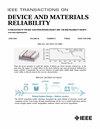FPGA Assessment Methodology of Adverse X-Ray Effects on Secure Digital Circuits
IF 2.3
3区 工程技术
Q2 ENGINEERING, ELECTRICAL & ELECTRONIC
IEEE Transactions on Device and Materials Reliability
Pub Date : 2025-02-21
DOI:10.1109/TDMR.2025.3538484
引用次数: 0
Abstract
Recent research demonstrates the feasibility of X-ray attacks. Unlike traditional fault injection methods, X-rays offer precise spatial targeting because of their short wavelength and high penetration power. This allows attackers to selectively target specific regions within a device, from individual transistors to larger blocks. This necessitates a new perspective on hardening techniques, requiring designers to consider the impact of X-ray irradiation on both fault injection and power consumption. To address this challenge, the paper proposes a characterization flow that analyzes the differences in side-channel leakages of FPGA components and their susceptibility to increased leakage due to X-ray effects. Despite the fundamental differences between ASIC and FPGA layouts, they both share the characteristic of being MOS technology-based, which makes them both susceptible to TID effects. The simulation results strongly support the theory that X-rays can induce leakage currents, thereby amplifying the side-channel information leakage observed in our experiments on FPGAs. Furthermore, these results provide concrete evidence that different FPGA components exhibit varying susceptibility to X-ray-induced leakage. Our findings reveal a clear hierarchy of vulnerability, with interconnects being the most susceptible elements, followed by registers, and lastly, logic components (LUTs and MUXes). This differential vulnerability offers valuable information for designers of secure cryptographic circuits. By understanding how X-rays impact different components, hardening techniques can be strategically targeted to provide the most effective protection against both fault injection and side-channel leakage.安全数字电路x射线不良影响的FPGA评估方法
最近的研究证明了x射线攻击的可行性。与传统的断层注入方法不同,x射线由于波长短、穿透能力强,可以提供精确的空间定位。这使得攻击者可以选择性地瞄准设备内的特定区域,从单个晶体管到更大的块。这就需要从新的角度来看待硬化技术,要求设计人员考虑x射线照射对断层注入和功耗的影响。为了解决这一挑战,本文提出了一个表征流程,分析了FPGA组件侧通道泄漏的差异以及它们对x射线效应导致的泄漏增加的易感性。尽管ASIC和FPGA布局之间存在根本差异,但它们都具有基于MOS技术的特征,这使得它们都容易受到TID效应的影响。仿真结果有力地支持了x射线可以诱导泄漏电流的理论,从而放大了我们在fpga实验中观察到的侧通道信息泄漏。此外,这些结果提供了具体的证据,表明不同的FPGA组件对x射线诱发泄漏的敏感性不同。我们的研究结果揭示了一个清晰的漏洞层次结构,互连是最易受影响的元素,其次是寄存器,最后是逻辑组件(lut和mux)。这种差异漏洞为安全加密电路的设计者提供了有价值的信息。通过了解x射线如何影响不同的组件,硬化技术可以有针对性地提供最有效的保护,防止断层注入和侧通道泄漏。
本文章由计算机程序翻译,如有差异,请以英文原文为准。
求助全文
约1分钟内获得全文
求助全文
来源期刊

IEEE Transactions on Device and Materials Reliability
工程技术-工程:电子与电气
CiteScore
4.80
自引率
5.00%
发文量
71
审稿时长
6-12 weeks
期刊介绍:
The scope of the publication includes, but is not limited to Reliability of: Devices, Materials, Processes, Interfaces, Integrated Microsystems (including MEMS & Sensors), Transistors, Technology (CMOS, BiCMOS, etc.), Integrated Circuits (IC, SSI, MSI, LSI, ULSI, ELSI, etc.), Thin Film Transistor Applications. The measurement and understanding of the reliability of such entities at each phase, from the concept stage through research and development and into manufacturing scale-up, provides the overall database on the reliability of the devices, materials, processes, package and other necessities for the successful introduction of a product to market. This reliability database is the foundation for a quality product, which meets customer expectation. A product so developed has high reliability. High quality will be achieved because product weaknesses will have been found (root cause analysis) and designed out of the final product. This process of ever increasing reliability and quality will result in a superior product. In the end, reliability and quality are not one thing; but in a sense everything, which can be or has to be done to guarantee that the product successfully performs in the field under customer conditions. Our goal is to capture these advances. An additional objective is to focus cross fertilized communication in the state of the art of reliability of electronic materials and devices and provide fundamental understanding of basic phenomena that affect reliability. In addition, the publication is a forum for interdisciplinary studies on reliability. An overall goal is to provide leading edge/state of the art information, which is critically relevant to the creation of reliable products.
 求助内容:
求助内容: 应助结果提醒方式:
应助结果提醒方式:


